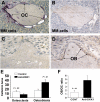Antibody-based inhibition of DKK1 suppresses tumor-induced bone resorption and multiple myeloma growth in vivo
- PMID: 17068150
- PMCID: PMC1801040
- DOI: 10.1182/blood-2006-09-047712
Antibody-based inhibition of DKK1 suppresses tumor-induced bone resorption and multiple myeloma growth in vivo
Abstract
Dickkopf-1 (DKK1), a soluble inhibitor of Wnt signaling secreted by multiple myeloma (MM) cells contributes to osteolytic bone disease by inhibiting the differentiation of osteoblasts. In this study, we tested the effect of anti-DKK1 therapy on bone metabolism and tumor growth in a SCID-rab system. SCID-rab mice were engrafted with primary MM cells expressing varying levels of DKK1 from 11 patients and treated with control and DKK1-neutralizing antibodies for 4 to 6 weeks. Whereas bone mineral density (BMD) of the implanted myelomatous bone in control mice was reduced during the experimental period, the BMD in mice treated with anti-DKK1 increased from pretreatment levels (P < .001). Histologic examination revealed that myelomatous bones of anti-DKK1-treated mice had increased numbers of osteocalcin-expressing osteoblasts and reduced number of multinucleated TRAP-expressing osteoclasts. The bone anabolic effect of anti-DKK1 was associated with reduced MM burden (P < .04). Anti-DKK1 also significantly increased BMD of the implanted bone and murine femur in nonmyelomatous SCID-rab mice, suggesting that DKK1 is physiologically an important regulator of bone remodeling in adults. We conclude that DKK1 is a key player in MM bone disease and that blocking DKK1 activity in myelomatous bones reduces osteolytic bone resorption, increases bone formation, and helps control MM growth.
Figures




References
-
- Barille-Nion S, Bataille R. New insights in myeloma-induced osteolysis. Leuk Lymphoma. 2003;44:1463–1467. - PubMed
-
- Roodman GD. Pathogenesis of myeloma bone disease. Blood Cells Mol Dis. 2004;32:290–292. - PubMed
-
- Sezer O. Myeloma bone disease. Hematology. 2005;10(suppl 1):19–24. - PubMed
-
- Berenson JR, Lichtenstein A, Porter L, et al. Efficacy of pamidronate in reducing skeletal events in patients with advanced multiple myeloma. Myeloma Aredia Study Group. N Engl J Med. 1996;334:488–493. - PubMed
-
- Berenson JR. Zoledronic acid in cancer patients with bone metastases: results of phase I and II trials. Semin Oncol. 2001;28:25–34. - PubMed
Publication types
MeSH terms
Substances
Grants and funding
LinkOut - more resources
Full Text Sources
Other Literature Sources
Medical

